To fulfill the rapid growth of bandwidth requirements in different fiber optic communication system applications, wavelength division multiplexing (WDM), dense wavelength division multiplexing (DWDM) systems, and fiber-to-the home (FTTH) networks have been introduced to employ newly designed optical fibers for better performance and reliabilities of high bit rate optical networks1 and long haul transmission optical systems.2-6 To increase the channel bit rate in a long haul transmission, the fiber nonlinearity effects should be avoided recommended by.7-10 Recent years, new fiber designs and further work have been introduced in high-capacity WDM transmission systems so as to minimize the nonlinearity effects and reduce down the signal distortion.11-18 In another work, a triangular segmented-core dispersion-shifted fibers was designed and fabricated with effective areas more than 80 µm2 which was later enhanced to about 90 µm2 by using a dual-ring profile.19
One of the popular fiber design, termed as Non-Zero Dispersion Shifted Fibers (NZDSF), operates in longer wavelength regions of 1530 to 1565 nm.20 A newer version of NZDSF is a large effective area fiber (LEAF), which provides greater effective area with a better performance compared with the previous NZDSF designs. It is shown that employing fibers with effective areas of 70 μm2 to 90 μm2 would increase the amplifier spacing considerably in comparison to systems using conventional 50 μm2 fibers.21
For the LEAF, different profiles are considered, e.g., Gaussian profile with ring,12 triangular–core profile with single ring and with dual ring,20 and depressed core triple-clad or quadruple-clad profile.22 The effective area, which could be obtained, ranges from 78 μm2 to 210 μm2.23 To minimize the dispersion penalty, the total dispersion should be small.24 Thus the concept of NZDSF was proposed.25-28 Typical dispersion value for NZDSFs is in the range of 3-8 ps/nm/km at 1550 nm with an effective area of about 50 μm2.29-32 NZDSFs have been widely deployed worldwide for high capacity WDM networks. Since the nonlinear effects are inversely proportional to the effective area of fiber, increasing the effective area will reduce further the nonlinear effects. To increase the effective area, different profiles designs with maximum large effective area of about 95 μm2 , 100 μm2, 100 μm2,150 μm2 were developed30,33 and fabricated34,35 respectively.
A design of depressed clad graded index NZDSF fiber with/without a central dip in the refractive index profile is reported, using the spot size optimization technique, by changing different fiber profile parameters to study the performance characteristics of the proposed NZDSF. By suitably adjusting these parameters, the obtained effective core area was about 80 μm2.36 In our previous attempt, we designed NZDSF fiber profile to reduce the positive dispersion and to enhance the negative dispersion. The obtained negative dispersion at 1550 nm wavelength were -528, -660, -710 ps/nm.km, from step-, triangular-, and exponential-index profiles, respectively.37
In later designs of NZDSFs, we have attempted to optimize theoretically the structural parameters of NZDSFs to improve the latency of optical networks such as internet of things (IoT), along with minimization of macro-bending losses of the designed fibers.38-41 In some particular cases the latencies were improved to 0.002 38 and 0.016.39
In this paper determination of design parameters for NZDSF of large effective area with a segmented-core profile with a raised ring is presented by using variational method based on Gaussian approximation for obtaining the effective area and other parameters of the designed fiber. We will show that with such a profile, if the parameters of the ring are determined appropriately, by using variational method, one can obtain enough large effective area for the LEAF fiber. We will show that among other parameters, the effective area is strongly dependent on the rate of evanescent field and the ring distance from the core. Our calculation have shown that the design values for the profile and variational parameters, such as values of the effective area, the mode field diameter (MFD), and the dispersion can be obtained with a simple mathematical calculations.
Index profile formulation
Let us consider a segmented-core profile with a raised ring located in the cladding in the vicinity of the core with a distance of p from the center, as shown in Figure 1.41 Mathematically, the profile of the fiber may be written as:

Figure 1 Segmented-core refractive index profile.
(1)
where
in which
and
are fiber core radius and the distance from the radius, respectively, and
are the respective relative index heights of the core and the ring, and
are width of the ring, refractive indices of core, cladding, and ring, respectively.
The fundamental mode field with a Gaussian function near and far from the fiber center is defined as:42,43
(2)
where
and
are constants for a given fiber and are found by minimizing the eigenvalue and obtaining a dimensionless parameters as:44
(3)
where
and
are the normalized frequency and profile function, respectively. From Figure 1, we define the function
and its integral as follows:
,
(4)
where
and
are delta Dirac functions at the beginning and end of the ring, respectively. In variational method, the value of
in equ. (3) should be minimized, which is equivalent to equating the parameter
to zero as follows:42
(5)
in which
is defined as:
(6)
By applying the modified Gaussian approximation,
can be written as:
(7)
where
is an incomplete Gamma function given as:45
(8)
Figure 2 shows the variation of
in terms of variational parameter
It is shown that for values of
greater than unity,
takes nearly constant values. On the other hand, equ. (2) shows that for a evanescent wave function in the cladding, we should have
, i.e.,
Thus, from Figure 2 for every value of
γ greater than unity, for almost constant value of
γ should satisfy the inequality
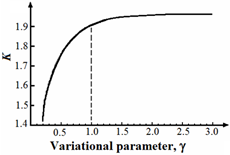
Figure 2 The Variations of
with respect to
.42
From
in equ. (2), we can determine the effective area
the
, the normalized cutoff frequency
and the bending loss
by using the following equations:43,46
,
(9)
,
where
is the fiber radius,
is the propagation constant,
is the normalized frequency,
and γ are constant related to β, and
represents the modified Bessel function.
For the chosen fiber profile, the variation of refractive index with respect to wavelength obtained by three-term Sellmeier formula, is determined by assuming 19.3% GeO2 for the core, 10.5% P2O5 for the ring indices, and a pure silica for the cladding region as follows:47
(10)
where
and
are Sellmeier coefficients, and λ denotes the wavelength. Then one can find β in terms of wavelength and thus calculate the total dispersion as:46
(11)
where
is the velocity of light in vacuum and λ denotes the operating wavelength. In Table 1, values of the coefficient in Sellmeier's formula for pure and doped silica are presented and the corresponding variations of
are illustrated in Figure 3.48 It is shown that the doping slightly changes the ZMDW.48
|
Samples: Dopants
(Mole%)
|
A: Pure SiO2
|
B: GeO2 (19.3%)
|
C: P2O5 (10.5%)
|
|
a1
|
0.004679148
|
0.005847345
|
0.005202431
|
|
a2
|
0.01351206
|
0.01552717
|
0.01287730
|
|
a3
|
97.93400
|
97.93484
|
97.93401
|
|
b1
|
0.6961663
|
0.7347008
|
0.7058489
|
|
b2
|
0.4079426
|
0.4461191
|
0.4176021
|
|
b3
|
0.8974794
|
0.8081698
|
0.8952753
|
Table 1 Values of coefficient in Sellmeier's formula for pure and doped silica48

Figure 3 Variation of
for pure and doped silica. Curve indicators A to C: correspond various samples given in Table 1.
Determination of design parameters
We assume that the propagating wave is a modified Gaussian function. If
is used in the core region, then we can write from equs. (7) and (11) as:
(12)
,
(13)
where
and
are given as follows:
,
,
(14)
in which
and
are incomplete Gamma functions and are evaluated by numerical integrations.
With reference to Figure 1, for every chosen values of
and
the values of
should be greater than the calculated normalized frequency. The variations of
in terms of
and
are plotted in Figure 4, where the fiber radius is taken as 3.5μm.

Figure 4 The variations of
as functions of (a)
with
and (b)
with
From equ. (13), the effective area and the values of
are directly evaluated in terms of variational parameters and are illustrated in Figure 5 respectively. The effective area
of the fiber strongly depends on γ values. Figure 5(a) indicates that for values of γ greater than 0.27, the
is less than that of NZDSF. Figure 5(b) shows that the
depends on monotonically decreasing values of γ parameter.
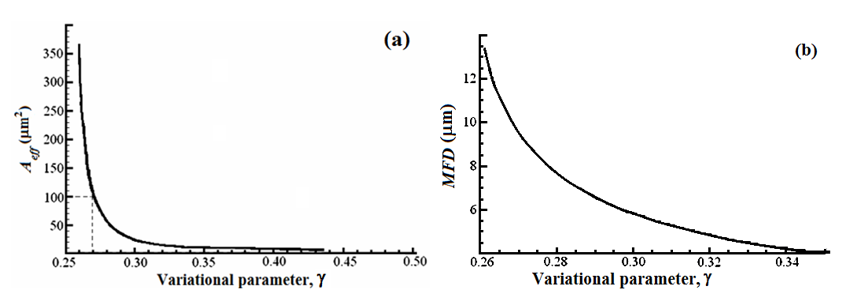
Figure 5 Dependences of (a)
on
and (b)
on
On the other hand,
and
increase when
increases, as shown in Figure 6. According to Fig. 6(a), variational parameter
is a criterion for pulse spread. On calculations, the values of
results in an
of greater than 11 μm which outranges the value recommended by ITU-T standard. Therefore, based on curves of Figures 6(a) and 6(b), the values related to
and
are not considered further in our analysis.

Figure 6 The variations of (a)
and (b)
as functions of
In equ. (12), it is shown that the variations of
directly depends on parameters such as
γ and the values of
and
Thus, these parameters should be chosen in such a way to satisfy
in equ. (12).
Figure 7 illustrates the quantity
in terms of
where other parameters are taken as
and
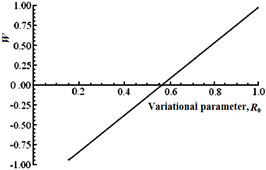
Figure 7 Variation of
in terms of
with
and
In Figure 8, the variations of
and
with respect to
while
are plotted, respectively. These curves show that whenever
varies between 1.5μm to 2.0 μm,
changes from 152.3
to 180
and the
increase from 9.19μm to 11.1μm respectively.
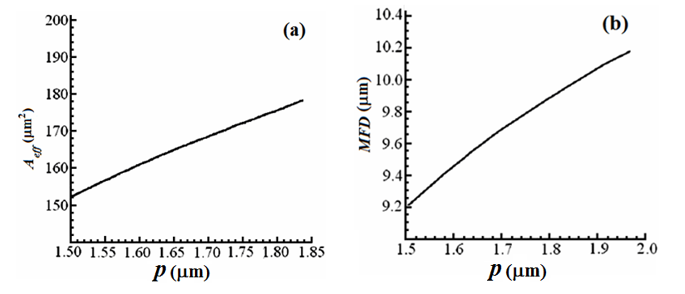
Figure 8 The variations of (a)
and (b)
as functions of
with
Simultaneous consideration of the curves in Figure 8 reveals that although for a given value of
may be a maximum, but at the same time
may exceed its upper standard limit. Thus the value of
should be chosen in such a way that both
and
attain standard values.
Similarly, in Figure 9, the curves are plotted versus
while
With the same reasoning, a design trade-off should be observed in this case, as well. Evaluation of Figures 8 and 9 show that
and
are more sensitive to
than to
i.e., the ring distance from the core center and the ring width, respectively. The sensitivity of
on
variations is more than that of
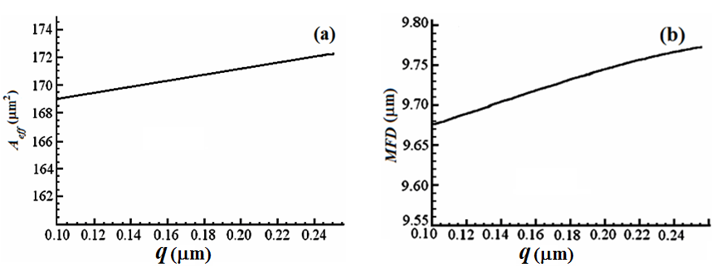
Figure 9 The variations of (a)
and (b)
as functions of
with
Another parameter which is affected by
and
variations, is the dispersion, as shown in Figure 10. In this case also, the variation of dispersion depends more on
than on
variations.

Figure 10 Dispersion (a) versus
with
and (b) versus
with
Bending loss is another parameter which is directly influenced by the height of the ring. To achieve a larger
design parameters would change in such a way that
and as a result, the bending loss increases, considerably. For this reason, a particular attention is needed to consider the bending loss as an important loss mechanism in the design procedure. In Figure 11, bending loss of the designed fiber is plotted versus the bending radius. The bending loss of 0.0053 dB/km is obtained against 35 mm bending radius by assuming
and
The summary of the designed parameters compared with experimental values are given in Table 2.

Figure 11 Bending loss versus bending radius.
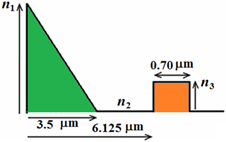
Figure 12 Designed segmented-core refractive index profile of NZDSF.
|
Parameters
|
Theoretical
|
Experimental
|
|
|
0.01864
|
0.01490
|
|
|
0.0046
|
0.0045
|
|
value
|
6.125μm
|
6.100μms
|
|
value
|
0.70μm
|
0.92μm
|
|
|
2.491
|
2.980
|
|
|
1175 nm
|
1216 nm
|
|
Core radius
|
3.5μm
|
3.25μm
|
Table 2 Theoretical and experimental values of some parameters of the designed NZDSF



